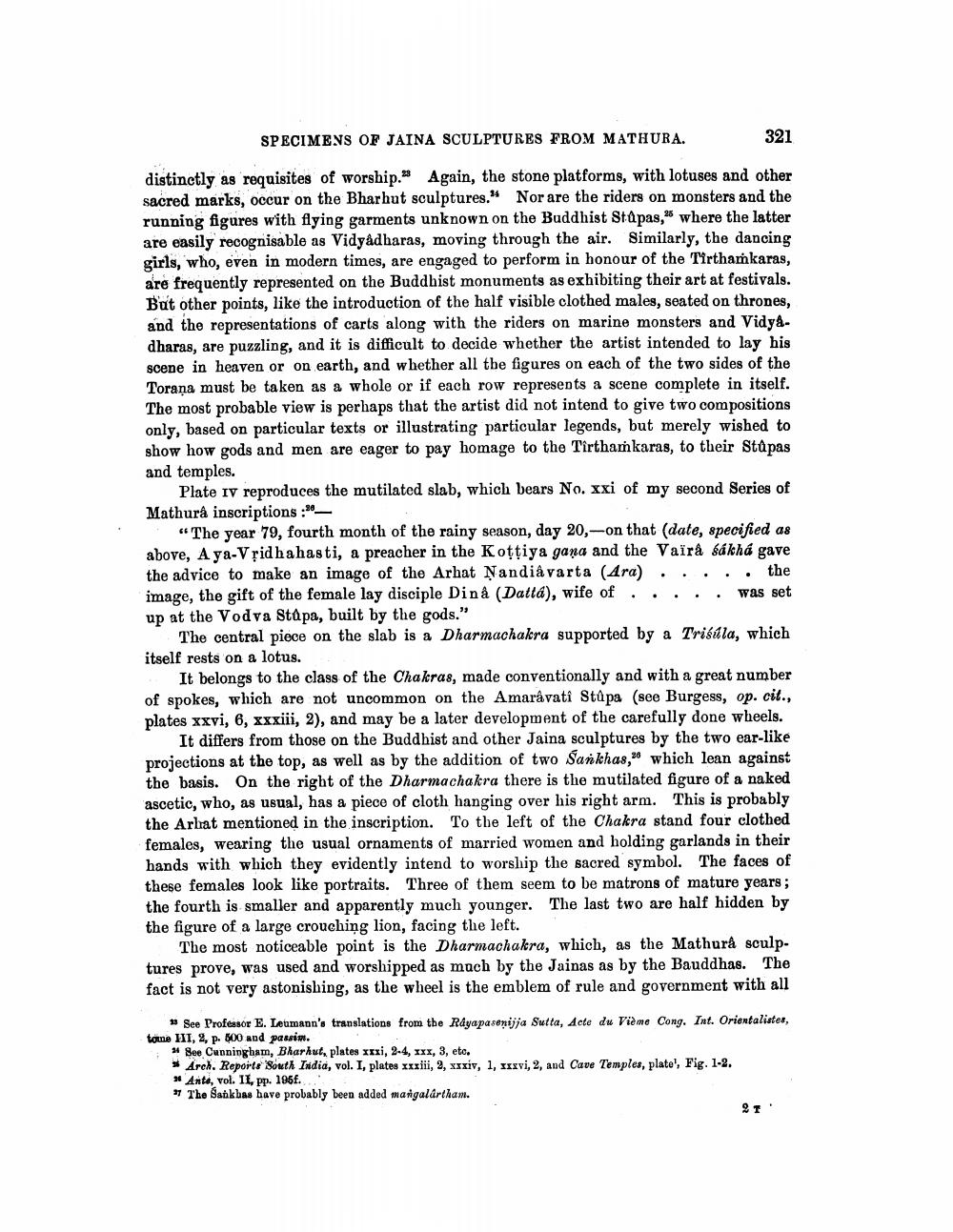________________
SPECIMENS OF JAINA SCULPTURES FROM MATHURA.
321
distinctly as requisites of worship. Again, the stone platforms, with lotuses and other sacred marks, occur on the Bharhut sculptures. Nor are the riders on monsters and the running figures with flying garments unknown on the Buddhist Stapas," where the latter are easily recognisable as Vidyadharas, moving through the air. Similarly, the dancing girls, who, even in modern times, are engaged to perform in honour of the Tirthamkaras, are frequently represented on the Buddhist monuments as exhibiting their art at festivals. But other points, like the introduction of the half visible clothed males, seated on thrones. and the representations of carts along with the riders on marine monsters and Vidya. dharas, are puzzling, and it is difficult to decide whether the artist intended to lay his scene in heaven or on earth, and whether all the figures on each of the two sides of the Toraņa must be taken as a whole or if each row represents a scene complete in itself. The most probable view is perhaps that the artist did not intend to give two compositions only, based on particular texts or illustrating particular legends, but merely wished to show how gods and men are eager to pay homage to the Tirthamkaras, to their Stupas and temples.
Plate Iv reproduces the mutilated slab, which bears No. xxi of my second Series of Mathura inscriptions :*
"The year 79, fourth month of the rainy season, day 20,-on that (date, specified as above, A ya-Vridh ahasti, a preacher in the Kottiya gana and the Vaïrà sá khá gave the advice to make an image of the Arhat Ņandiâvarta (Ara) .....the image, the gift of the female lay disciple Dinà (Datta), wife of ..... was set up at the Vodva Stapa, built by the gods."
The central piece on the slab is a Dharmachakra supported by a Triśúla, which itself rests on a lotus.
It belongs to the class of the Chakras, made conventionally and with a great number of spokes, which are not uncommon on the Amaravati Stúpa (see Burgess, op. cit., plates xxvi, 6, xxxiii, 2), and may be a later development of the carefully done wheels.
It differs from those on the Buddhist and other Jaina sculptures by the two ear-like projections at the top, as well as by the addition of two Sanchas," which lean against the basis. On the right of the Dharmachakra there is the mutilated figure of a naked ascetic, who, as usual, has a piece of cloth hanging over his right arm. This is probably the Arlat mentioned in the inscription. To the left of the Chakra stand four clothed females, wearing the usual ornaments of married women and holding garlands in their hands with which they evidently intend to worship the sacred symbol. The faces of these females look like portraits. Three of them seem to be matrons of mature years ; the fourth is smaller and apparently much younger. The last two are half hidden by the figure of a large crouching lion, facing the left.
The most noticeable point is the Dharmachakra, which, as the Mathura sculptures prove, was used and worshipped as much by the Jainas as by the Bauddhas. The fact is not very astonishing, as the wheel is the emblem of rule and government with all
** See Professor E. Leumann's translations from the Rayapasenijja Sutta, Acte du Viamo Cong. Int. Orientalistes, tome III, 4, p. 600 and passim.
* Boo Cunningham, Bharhut, plates xxxi, 2-4, xxx, 3, eto.
Arch. Reports South India, vol. I, plates xxxiii, 9, xxxiv, 1, XXXVI, 2, and Cave Temples, plato), Fig. 1-2. * Ante, vol. II, pp. 196f. » The Sankbas have probably been added mangalartham.




